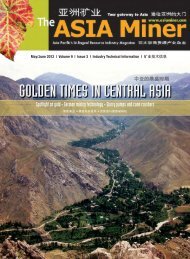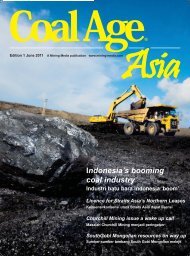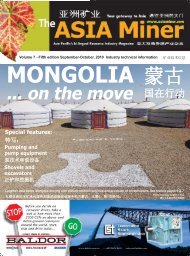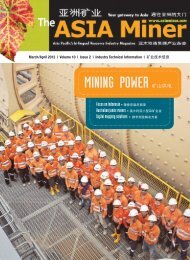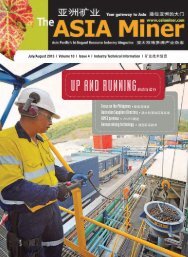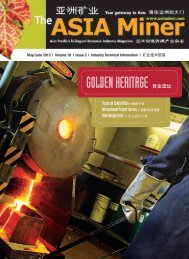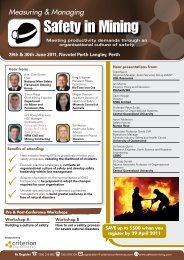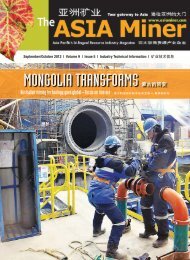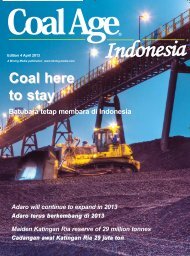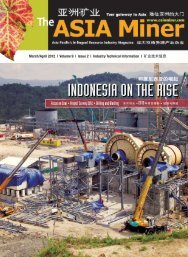MINING WELCOME 欢迎采矿 - The ASIA Miner
MINING WELCOME 欢迎采矿 - The ASIA Miner
MINING WELCOME 欢迎采矿 - The ASIA Miner
You also want an ePaper? Increase the reach of your titles
YUMPU automatically turns print PDFs into web optimized ePapers that Google loves.
FIRST ore has been processed at Hillgrove<br />
Resources’ flagship Kanmantoo Copper Project<br />
in South Australia, bringing the mine into<br />
production for the first time in 35 years. Construction<br />
was essentially completed in the<br />
first week of November and the company is<br />
now producing its first concentrates.<br />
<strong>The</strong> first throughput has been from stockpiled,<br />
crushed, low-grade ore to test the plant<br />
and optimize performance. <strong>The</strong> facility is now<br />
working on 300,000 tonnes of higher grade<br />
ore of between 0.7-0.9% copper. <strong>The</strong> first<br />
shipment of concentrate is expected to leave<br />
Port Adelaide in early 2012.<br />
<strong>The</strong> $135-million open-cut project includes<br />
a crushing facility, tailings storage dam and<br />
ball mill. Hillgrove has also manufactured 450<br />
haulage and storage containers for the shipping<br />
of concentrate from Port Adelaide.<br />
Hillgrove’s managing director Drew Simonsen<br />
says, “<strong>The</strong> achievement of this milestone<br />
changes the company from ‘developer’ to<br />
‘producer’ status. <strong>The</strong> combination of a producing<br />
mine at Kanmantoo, continuing exploration<br />
successes in the immediate vicinity of the<br />
pit suggesting a Life-of-Mine extension is very<br />
probable, and our portfolio of highly prospective<br />
Indonesian exploration properties sets the<br />
company up for a strong growth trajectory.”<br />
Kanmantoo is about 55km from Adelaide,<br />
in the Adelaide Hills. Its initial annual throughput<br />
will be 2.4 million tonnes, producing<br />
80,000 tonnes of concentrate, 20,000 tonnes<br />
GEOLOGICAL dating of selected samples<br />
from Tasman Resources’ Vulcan iron oxide<br />
copper gold uranium (IOCGU) project has estimated<br />
the average age of mineralization at<br />
1590 million years. This is essentially the<br />
same geological age as other significant<br />
nearby IOCGU deposits, including Olympic<br />
Dam, Prominent Hill and Carapateena.<br />
Tasman’s executive chairman Greg Solomon<br />
says the dating confirms Vulcan is part of a significant<br />
family of ore deposits and with further<br />
investigation could prove to be a major deposit<br />
itself. <strong>The</strong> dating program is being funded and<br />
technically coordinated by the South Australian<br />
Government through its PACE 2020 initiative,<br />
which is the government’s plan for accelerated<br />
exploration of potential mineral deposits and the<br />
Vulcan in significant family of ore deposits<br />
of copper metal and 10,000 ounces of gold<br />
per year, over a 6 year mine life. Hillgrove will<br />
ramp up production through to June 2012.<br />
Kanmantoo’s general manager Cam Schubert<br />
says the mine is almost at full staff capacity<br />
with 75 employees on site. “<strong>The</strong>se are<br />
certainly exciting times for the Kanmantoo<br />
copper mine. One of the most pleasing aspects<br />
of the project to date has been the opportunity<br />
to grow our workforce as we head<br />
towards sustainable operations.”<br />
Kanmantoo has been intermittently mined<br />
since the 1840s and has recorded production<br />
of 39,000 tonnes of copper metal. Hillgrove<br />
acquired the old copper mine pit in 2004 and<br />
says it remains one of the most under-explored<br />
and prospective metal provinces in<br />
<strong>The</strong> processing facilities at Hillgrove Resources’ Kanmantoo project in South Australia.<br />
development of mining operations. <strong>The</strong> $30.9<br />
million, seven-year funding program is under<br />
the direction of the Primary Industries and Resources<br />
Department and includes support for<br />
drilling programs and new geological surveys.<br />
<strong>The</strong> Vulcan project secured PACE funding<br />
in May 2011 to assist Tasman in understanding<br />
the local geology as well as helping to<br />
guide further drill programs and exploration<br />
for high grade mineralization within the deposit<br />
area. Greg Solomon says the funding<br />
will help place Vulcan and its host rocks in a<br />
regional geological framework.<br />
Initial results at Vulcan confirm measurement<br />
of rhenium and osmium isotopes in molybdenite<br />
which occurs as part of the IOCGU mineralization<br />
in most drill holes to date.<br />
Australia<br />
Australia, showing great potential for coppergold<br />
and silver-lead-zinc mineralization.<br />
Since then the company has worked to<br />
confirm a resource estimate, complete a feasibility<br />
study and rehabilitation plan as well as<br />
the design and construction of the new mine<br />
and nearby roads. <strong>The</strong> tailings storage facility<br />
has been constructed using best practice environmental<br />
guidelines with a clay liner,<br />
drainage networks and decant pipeline with<br />
a HDPE lining on top.<br />
<strong>The</strong> mine’s proximity to a capital city has<br />
helped to keep construction on schedule. It<br />
has access to low cost grid power, treated<br />
waste water from the nearby town of Mount<br />
Barker and is 3km from the highway that links<br />
the area with export facilities at Port Adelaide.<br />
Kanmantoo transforms Hillgrove into a producer<br />
Tasman is also about to start drilling at its<br />
highly prospective Lucas Hill IOCGU target in<br />
South Australia, about 150km south of Vulcan.<br />
<strong>The</strong> basement-sourced gravity anomaly<br />
appears to be larger in area and of comparable<br />
strength to the Carapateena deposit,<br />
which is about 50km northeast.<br />
Greg Solomon says geophysical modeling<br />
indicates that the source of gravity and magnetic<br />
anomalies at Lucas Hill is likely to be a<br />
significant body of quite dense material. “<strong>The</strong><br />
body becomes more magnetic at depth.<br />
Drilling will consist of an initial two drill holes<br />
and further drilling will depend upon results.<br />
Aboriginal heritage clearance has been obtained<br />
for these initial drill holes and drilling<br />
will begin in mid-January.”<br />
January/February 2012 | <strong>ASIA</strong> <strong>Miner</strong> | 23



